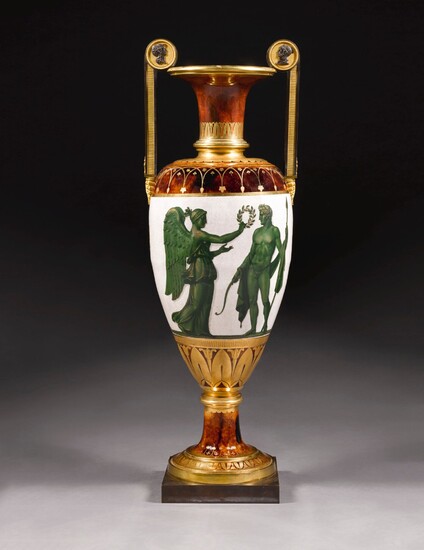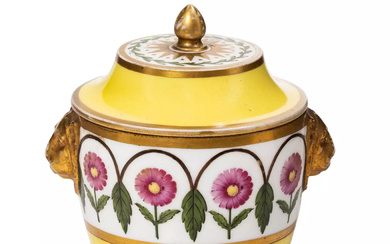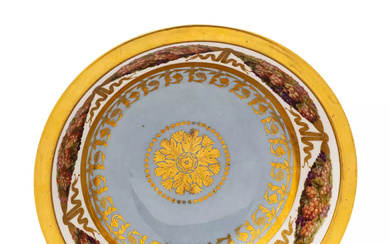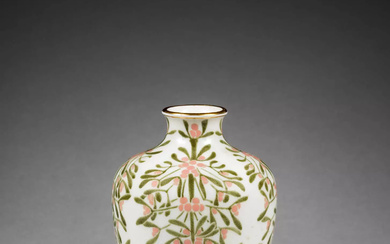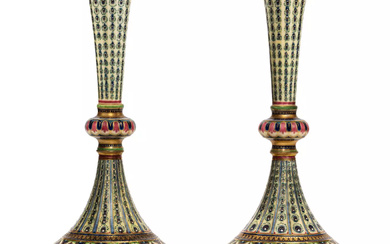A gilt-bronze-mounted Sevres vase, 1810
A gilt-bronze-mounted Sevres vase, 1810
Vase fuseau, première grandeur, the slender ovoid body with a flared neck and spreading foot, painted and gilt to simulate patinated bronze with a frieze of an athlete being crowned with a wreath by Victory, the reverse gilt with an elaborate geometric spray of palmettes and stylised leaves, on a ground gilt with stippled ornament, between fond écaille tortoise-shell pattern ground sections, the lower part gilt with bands of stiff leaves and buds, the shoulder with arched band, the neck with a further band of stiff leaves, with gilt-bronze collars to the neck and stem, supported on a square base, the upright handles terminating in classical portrait roundels in patinated bronze relief
Iron-red stencilled M.Impl/de Sevres/10 mark, gilt GJ 28M
107 cm. high; 40 ¾ in.
Provenance:
EXHIBITED
Naples, Museo di Capodimonte, October 1997-April 1998.
LITERATURE
Civiltà dell'Ottocento. Le arti figurative, exhibition catalogue, Naples 1997, pp. 56-57, fig. 1.9.
This magnificent vase fuseau is an important example of the type of vases produced by Sevres for the Emperor of the French, Napoléon who often offered them as diplomatic gifts. Of première grandeur, the largest size of vase produced at Sèvres, the classical scene on the front can be read as an allegory of the coronation of Napoleon by Nike, the goddess personifying victory. This vase promotes the predominant artistic style in France under the Napoleonic Empire , Neoclassicism. Spearheaded by the painter Jacques Louis-David and influenced by a rediscovery of the art of the ancient world, vases of this type were for the Emperor an effective means to spread his political and moral values and exhibit his grandeur and glory. It is against this background that this vase has to be examined. The historical documents recording the specific design and production of the vase further point to the importance of this vase.
DESIGN
The archives of the Manufacture de Sèvres record the design and execution of this vase. The 'Vase fuseau' was first conceived in 1800 by the architect Alexandre-Théodore Brongniart (1739-1813), father of the director of the factory; it was redesigned in 1803 and 1806. It proved popular in the Napoléonic era and beyond and was often embellished with gilt-bronze mounts. The design for the frieze and the leaf ornament survives in the archive of the factory and is signed by Claude-Charles Gérard (1757-1826), to whom the design is attributed (fig.1) [1]. The design is inscribed “décore de vase fuseau 1e gr pour essay des matières di Vase Medicis 1e gr. Fond écaille, figures en vert au grand feu, ornaments en or et en platine”. Further documentation in the archives indicate that in 1809 a vase Medici of the first size was planned with ornament “bas relief tournant, en figures peintes en vert dechrome au grand feu”[2].
The design for the figure group is derived from an illustration from Sir William Hamilton (1730-1803) and Pierre-François Hugues d’Hancarville (1719-1805), Collection of Etruscan, Greek and Roman antiquities from the cabinet of the Hon. W. Hamilton his Majesty’s envoy extraordinary and plenipotentiary at the Court of Naples, 1766/7, Vol. IV, pl. 116 (fig.2). Published in Naples by François Morelli, it illustrates the collection formed by Sir William which incorporated the Porcinari family collection of classical antiquities. Publication of all four volumes was interrupted by Baron d’Hancarville’s expulsion from Naples but the completed volumes, with over 400 illustrations went on to have the most profound influence on design and the applied arts. Hamilton’s collection was sold to the British Museum in 1772 and the bell-krater from which this plate was taken is held in the collection (inv. no. 1772,0320.526) - fig.3. [3]
The ‘fond écaille’ ground colour used to simulate a deep lustrous tortoiseshell was first used at Sèvres in the 1780s on vases, sometimes embellished with gilt-bronze mounts supplied by the celebrated bronzier Pierre-Philippe Thomire (1751-1843) as well as for services. The popularity of the ground colour went through a resurgence in about 1800 and was frequently chosen by Napoléon for personal and diplomatic use, examples include a service delivered to the Emperor on 5th December 1804, consisting of seventy-two plates tortoise-shell ground imitating bronze figures etc, priced at 54 francs each. [4]
PRODUCTION
The factory archive records the progress of this vase throughout production and the finished vase was sent to the magasin on 12th December 1810, it describes “Un vase fuseau 1ére gr. Fond écaille et pointillé en or imprimé; figures peintes en vert de chrome au grand feu, décoré d’ornements en or brunis à l’effet” [5] - fig.4. The costs were listed as:
Pâte 300
Fond 200
Dorure des ornements 65
Impression 36
Or 105
Peintures des figures par Béranger 50
Brunissage à l’effet 36
Brunissage à plat 32
____
Total des frais directs 824
Faux frais, montage en bronze
Prix de fabrication 1324
Prix de vente 1500
(défectueux)
Payment records also survive of the individual workers involved at various stages of production. Following the commencement of work in late 1809 the painter, Legros was paid for the decoration of the ground in February 1810: “1 vase fuseau 1ere essay de fond pointillé, estimé 3 jours de travaille”[6] perhaps referring to the precisely ornamented background of the band round the middle of the vase. Béranger was paid for the painting of the figures in April of the same year: “1 vase fuseau 1ere grandeur pour deux grandes figures dans le stil étrusque, peint en vert de chrome pour essay de decore d’un vase, 50 francs”. [7] The gilding was added by Morin in October 1810: “1 vase fuseau d’écaille figures chrome de Beranger”.[8]
The “Recueil des travaux des peintres, doreurs etc…” for 1810[9] which records payments to the bronze suppliers Thomire and Delafontaine, does not appear to mention the gilt-bronze mounts of this vase. However, another record refers to the vase on 12th December 1810 “1 vase dit fuseau 1ere gdeur fond écaille figures peins en vert de chrome au gd feu, anses en bronze” [10] indicating that the addition of gilt-bronze handles was contemporary and may have been supplied form an existing stock of parts.
The gilt-bronze mounts of this vase may be attributed to Thomire on the basis of his style and outstanding quality. He was the most celebrated bronzier in addition to Pierre Gouthière during the reign of Louis XVI. During the Napoleonic period, his business flourished and he became a favourite of Napoléon who made him in 1809 Ciseleur de L'Empereur. The bronzier often worked for the Sèvres Manufacture and is known to have supplied gilt-bronze mounts for vases destined for the Emperor. For example, a vase fuseau in the collections of the Château de Versailles features highly similar handles in comparison with the present vase (inv.no. V1926.1). While at Versailles, the medallions at the tip of the handles depict
the Emperor and his wife, the Empress Joséphine, this vase depict faces of soldiers, thus emphasizing the function of the vase as a representation of the military victories of Napoléon.
THE MANUFACTURE DE SEVRES AT THE TIME OF THE FIRST EMPIRE (1800-1815)
In May 1800, Alexandre Brongniart was appointed director of the Sèvres factory by Lucien Bonaparte (1775-1840), Minister of the Interior and younger brother of the First Consul. Brongniart was a shrewd appointment, the son of the architect Alexandre-Théodore Brongniart, Alexandre was a polymath who was responsible for the revival of the factory’s fortunes following the hiatus of the Revolution and the First Republic. He ushered in an era of technical innovation and perfection by drawing on the wealth of design and artistic talent in Paris in the early years of the 19th century. Perhaps more that any of his predecessors he was able to amalgamate the talents of skilled artists in a variety of decorative disciplines to produce objects of a scale and quality which has not been achieved before. The early years of his tenure see the creation of porcelain services, objects of form and furnishings which employ a simplicity which rejects the elaborate rococo of the ancient regime, uses a decorative repertoire drawn from the purity of ancient classicism and projected France as the centre of an Empire.
NAPOLÉON AND SEVRES
Whilst the provenance of the present vase has not been established with certainty it was produced in exactly the period when Napoléon (1769-1821) was the most influential patron of the Sèvres factory. Like the Bourbon rulers before him, Napoléon realised the potential for art as propaganda and its use in diplomacy. Equally, Brongniart like his predecessors would have tried to anticipate the tastes and needs for his main patron as well as delivering specific commissions. Not unlike Louis XV and his circle, the Emperor used lavish gifts of porcelain and other luxury goods to present to the influential elite of the day as well as for his own use and as gifts of his immediate family. Given the morganatic nature of familial relations within the Bonaparte family, the line between family gift and diplomatic offering is often blurred. It is possible to trace a new iconography in the products of the factory which place the Emperor and his family at the centre of the work. Most explicitly there are objects which portray the Emperor or a family member in a traditional portrait. However, one begins to see representations which show the influence of contemporary and ancient art which redefines the image of the Emperor and his family. Examples include the vase fuseau presented to his mother (Musée du Louvre, in.no. no. OA 11056), Madame Mère (1750-1836) in 1811 on the christening of Napoléon’s son, King of Rome to whom Mme Mère was also godmother (fig.5). This impressive vase, similar in form, scale and ground colour to the present vase depicts Napoléon crossing the Alps after the...
View it on
Estimate
Time, Location
Auction House
A gilt-bronze-mounted Sevres vase, 1810
Vase fuseau, première grandeur, the slender ovoid body with a flared neck and spreading foot, painted and gilt to simulate patinated bronze with a frieze of an athlete being crowned with a wreath by Victory, the reverse gilt with an elaborate geometric spray of palmettes and stylised leaves, on a ground gilt with stippled ornament, between fond écaille tortoise-shell pattern ground sections, the lower part gilt with bands of stiff leaves and buds, the shoulder with arched band, the neck with a further band of stiff leaves, with gilt-bronze collars to the neck and stem, supported on a square base, the upright handles terminating in classical portrait roundels in patinated bronze relief
Iron-red stencilled M.Impl/de Sevres/10 mark, gilt GJ 28M
107 cm. high; 40 ¾ in.
Provenance:
EXHIBITED
Naples, Museo di Capodimonte, October 1997-April 1998.
LITERATURE
Civiltà dell'Ottocento. Le arti figurative, exhibition catalogue, Naples 1997, pp. 56-57, fig. 1.9.
This magnificent vase fuseau is an important example of the type of vases produced by Sevres for the Emperor of the French, Napoléon who often offered them as diplomatic gifts. Of première grandeur, the largest size of vase produced at Sèvres, the classical scene on the front can be read as an allegory of the coronation of Napoleon by Nike, the goddess personifying victory. This vase promotes the predominant artistic style in France under the Napoleonic Empire , Neoclassicism. Spearheaded by the painter Jacques Louis-David and influenced by a rediscovery of the art of the ancient world, vases of this type were for the Emperor an effective means to spread his political and moral values and exhibit his grandeur and glory. It is against this background that this vase has to be examined. The historical documents recording the specific design and production of the vase further point to the importance of this vase.
DESIGN
The archives of the Manufacture de Sèvres record the design and execution of this vase. The 'Vase fuseau' was first conceived in 1800 by the architect Alexandre-Théodore Brongniart (1739-1813), father of the director of the factory; it was redesigned in 1803 and 1806. It proved popular in the Napoléonic era and beyond and was often embellished with gilt-bronze mounts. The design for the frieze and the leaf ornament survives in the archive of the factory and is signed by Claude-Charles Gérard (1757-1826), to whom the design is attributed (fig.1) [1]. The design is inscribed “décore de vase fuseau 1e gr pour essay des matières di Vase Medicis 1e gr. Fond écaille, figures en vert au grand feu, ornaments en or et en platine”. Further documentation in the archives indicate that in 1809 a vase Medici of the first size was planned with ornament “bas relief tournant, en figures peintes en vert dechrome au grand feu”[2].
The design for the figure group is derived from an illustration from Sir William Hamilton (1730-1803) and Pierre-François Hugues d’Hancarville (1719-1805), Collection of Etruscan, Greek and Roman antiquities from the cabinet of the Hon. W. Hamilton his Majesty’s envoy extraordinary and plenipotentiary at the Court of Naples, 1766/7, Vol. IV, pl. 116 (fig.2). Published in Naples by François Morelli, it illustrates the collection formed by Sir William which incorporated the Porcinari family collection of classical antiquities. Publication of all four volumes was interrupted by Baron d’Hancarville’s expulsion from Naples but the completed volumes, with over 400 illustrations went on to have the most profound influence on design and the applied arts. Hamilton’s collection was sold to the British Museum in 1772 and the bell-krater from which this plate was taken is held in the collection (inv. no. 1772,0320.526) - fig.3. [3]
The ‘fond écaille’ ground colour used to simulate a deep lustrous tortoiseshell was first used at Sèvres in the 1780s on vases, sometimes embellished with gilt-bronze mounts supplied by the celebrated bronzier Pierre-Philippe Thomire (1751-1843) as well as for services. The popularity of the ground colour went through a resurgence in about 1800 and was frequently chosen by Napoléon for personal and diplomatic use, examples include a service delivered to the Emperor on 5th December 1804, consisting of seventy-two plates tortoise-shell ground imitating bronze figures etc, priced at 54 francs each. [4]
PRODUCTION
The factory archive records the progress of this vase throughout production and the finished vase was sent to the magasin on 12th December 1810, it describes “Un vase fuseau 1ére gr. Fond écaille et pointillé en or imprimé; figures peintes en vert de chrome au grand feu, décoré d’ornements en or brunis à l’effet” [5] - fig.4. The costs were listed as:
Pâte 300
Fond 200
Dorure des ornements 65
Impression 36
Or 105
Peintures des figures par Béranger 50
Brunissage à l’effet 36
Brunissage à plat 32
____
Total des frais directs 824
Faux frais, montage en bronze
Prix de fabrication 1324
Prix de vente 1500
(défectueux)
Payment records also survive of the individual workers involved at various stages of production. Following the commencement of work in late 1809 the painter, Legros was paid for the decoration of the ground in February 1810: “1 vase fuseau 1ere essay de fond pointillé, estimé 3 jours de travaille”[6] perhaps referring to the precisely ornamented background of the band round the middle of the vase. Béranger was paid for the painting of the figures in April of the same year: “1 vase fuseau 1ere grandeur pour deux grandes figures dans le stil étrusque, peint en vert de chrome pour essay de decore d’un vase, 50 francs”. [7] The gilding was added by Morin in October 1810: “1 vase fuseau d’écaille figures chrome de Beranger”.[8]
The “Recueil des travaux des peintres, doreurs etc…” for 1810[9] which records payments to the bronze suppliers Thomire and Delafontaine, does not appear to mention the gilt-bronze mounts of this vase. However, another record refers to the vase on 12th December 1810 “1 vase dit fuseau 1ere gdeur fond écaille figures peins en vert de chrome au gd feu, anses en bronze” [10] indicating that the addition of gilt-bronze handles was contemporary and may have been supplied form an existing stock of parts.
The gilt-bronze mounts of this vase may be attributed to Thomire on the basis of his style and outstanding quality. He was the most celebrated bronzier in addition to Pierre Gouthière during the reign of Louis XVI. During the Napoleonic period, his business flourished and he became a favourite of Napoléon who made him in 1809 Ciseleur de L'Empereur. The bronzier often worked for the Sèvres Manufacture and is known to have supplied gilt-bronze mounts for vases destined for the Emperor. For example, a vase fuseau in the collections of the Château de Versailles features highly similar handles in comparison with the present vase (inv.no. V1926.1). While at Versailles, the medallions at the tip of the handles depict
the Emperor and his wife, the Empress Joséphine, this vase depict faces of soldiers, thus emphasizing the function of the vase as a representation of the military victories of Napoléon.
THE MANUFACTURE DE SEVRES AT THE TIME OF THE FIRST EMPIRE (1800-1815)
In May 1800, Alexandre Brongniart was appointed director of the Sèvres factory by Lucien Bonaparte (1775-1840), Minister of the Interior and younger brother of the First Consul. Brongniart was a shrewd appointment, the son of the architect Alexandre-Théodore Brongniart, Alexandre was a polymath who was responsible for the revival of the factory’s fortunes following the hiatus of the Revolution and the First Republic. He ushered in an era of technical innovation and perfection by drawing on the wealth of design and artistic talent in Paris in the early years of the 19th century. Perhaps more that any of his predecessors he was able to amalgamate the talents of skilled artists in a variety of decorative disciplines to produce objects of a scale and quality which has not been achieved before. The early years of his tenure see the creation of porcelain services, objects of form and furnishings which employ a simplicity which rejects the elaborate rococo of the ancient regime, uses a decorative repertoire drawn from the purity of ancient classicism and projected France as the centre of an Empire.
NAPOLÉON AND SEVRES
Whilst the provenance of the present vase has not been established with certainty it was produced in exactly the period when Napoléon (1769-1821) was the most influential patron of the Sèvres factory. Like the Bourbon rulers before him, Napoléon realised the potential for art as propaganda and its use in diplomacy. Equally, Brongniart like his predecessors would have tried to anticipate the tastes and needs for his main patron as well as delivering specific commissions. Not unlike Louis XV and his circle, the Emperor used lavish gifts of porcelain and other luxury goods to present to the influential elite of the day as well as for his own use and as gifts of his immediate family. Given the morganatic nature of familial relations within the Bonaparte family, the line between family gift and diplomatic offering is often blurred. It is possible to trace a new iconography in the products of the factory which place the Emperor and his family at the centre of the work. Most explicitly there are objects which portray the Emperor or a family member in a traditional portrait. However, one begins to see representations which show the influence of contemporary and ancient art which redefines the image of the Emperor and his family. Examples include the vase fuseau presented to his mother (Musée du Louvre, in.no. no. OA 11056), Madame Mère (1750-1836) in 1811 on the christening of Napoléon’s son, King of Rome to whom Mme Mère was also godmother (fig.5). This impressive vase, similar in form, scale and ground colour to the present vase depicts Napoléon crossing the Alps after the...
